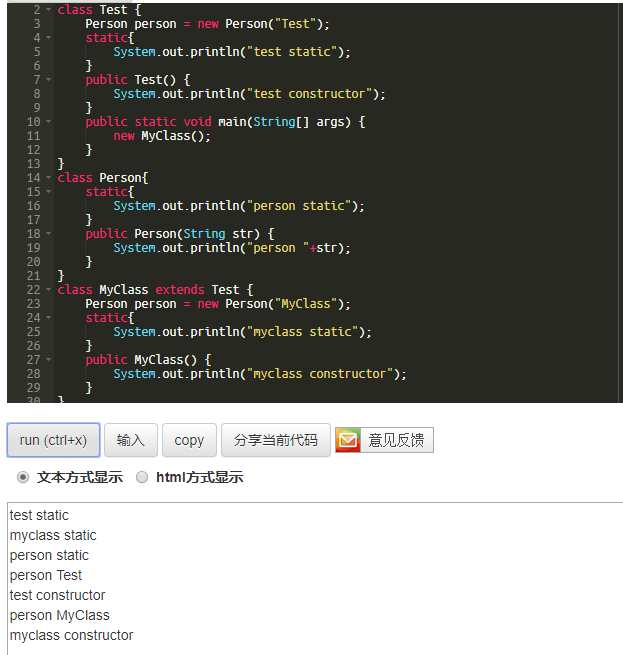为什么不能用abstract修饰属性,私有方法,构造器,静态方法,final的方法?

abstract
抽象: 程序中不能被new创建的?父类,抽象,不完整,不具体,不能独立存在。通过 abstract 修饰类,意为抽象类,不能new对象
abstract: 抽象的,似是而非,像却又不是,具备某种对象的特征,但不完整
abstract修饰类概念: 不够完整,不够具体,不能独立存在
语法: abstract class 类名 { }
abstract修饰类:
- 抽象类,不能直接独立new对象;
- 可被子类继承,提供共性属性和方法;
- 可声明为引用,强制使用多态(更纯粹的多态);
- 抽象类的构造方法作用:构建子类对象时,先构建父类对象,(父类共性 + 子类独有 = 完整子类对象)
经验:abstract修饰后的抽象父类,依附于子类对象存在。
abstract修饰方法概念:抽象方法,不够完整、不够具体
语法:访问权限修饰符 abstract 返回值类型 函数名([参数列表]);
abstract修饰方法:
- 只有方法声明,没有方法实现;
- 必须包含在抽象类中(abstract class XX{});
- 强制子类必须实现该方法,提供完整的、具体的调用版本;
总结:
子类继承抽象类,子类必须覆盖父类中所有的抽象方法,否则子类还是抽象类;
抽象类中不一定有抽象方法,但有抽象方法的类一定是抽象类。
1
2
3
4
5
6
7
8
9
10
11
12
13
14
15
16
17
18
19
20
21
22
23
24
25
26
27
28
29
30
31
32
33
34
35
36
37
38
39
| public class TestAbstract {
public static void main(String[] args) {
new NewDog();
OneAnimal a = new NewDog();
a.eat();
}
}
abstract class OneAnimal {
String breed;
int age;
String sex;
public OneAnimal() {
System.out.println("OneAnimal()");
}
public abstract void eat();
public void sleep() {
System.out.println();
}
}
class NewDog extends OneAnimal {
public NewDog() {
System.out.println("Dog()");
}
@Override
public void eat() {
System.out.println("狗在吃骨头...");
}
}
|
abstract修饰类:
- 抽象类,不能直接独立new对象;
- 可被子类继承,提供共性属性和方法;
- 可声明为引用,强制使用多态(更纯粹的多态);
abstract修饰方法:
- 只有方法声明,没有方法实现;
- 必须包含在抽象类中(abstract class XX{});
- 强制子类必须实现该方法,提供完整的、具体的调用版本;
static
实例属性,是每个对象各自持有的独立内存空间(多份),对象单方面修改,不会影响其他对象。
静态属性,static 修饰的实例属性,为。静态属性,是整个类共同持有的共享空间(一份),任何对象修改,都会影响其他对象。
Java中规定:不能将方法体内的局部变量声明为 static!
静态属性:类属性
静态方法:类方法
不必创建对象,可直接通过类名访问【推荐】:类名.静态成员
1
2
3
4
5
6
7
8
9
10
11
12
13
14
15
16
17
18
19
20
21
22
23
24
25
26
27
28
29
30
31
32
33
34
35
36
37
38
39
40
41
42
43
44
45
46
47
48
49
50
51
52
53
54
55
| public class TestStaticField {
public static void main(String[] args) {
MyClass mc1 = new MyClass();
mc1.a = 10;
MyClass.b = 100;
MyClass mc2 = new MyClass();
mc2.a = 20;
MyClass.b = 200;
System.out.println(mc1.a + " " + mc2.a);
System.out.println(MyClass.b + " " + MyClass.b);
System.out.println();
mc1.method2();
System.out.println();
mc2.method2();
}
}
class MyClass {
int a;
static int b;
static double PI = 3.14;
public static void method1() {
System.out.println("method1()...");
}
public void method2() {
System.out.println(MyClass.b);
System.out.println(MyClass.PI);
MyClass.method1();
}
}
|
1
2
3
4
5
6
7
8
9
10
11
12
13
14
15
16
17
18
19
20
21
22
23
24
25
|
public class TestApplyStaticField {
public static void main(String[] args) {
Student[] stus = new Student[10];
for (int i = 0; i < stus.length; i++) {
stus[i] = new Student();
}
System.out.println("count最终值:" + Student.getCount());
}
}
class Student {
private static int count = 0;
public Student() {
count++;
}
public static int getCount() {
return count;
}
}
|
如这几个常见的静态方法,均使用类名直接调用
- Arrays.copyOf();
- Arrays.sort();
- Math.random();
- Math.sqrt();
静态方法规则:
- 静态方法允许直接访问静态成员(不需要this.);
- 静态方法不允许直接访问非静态成员;
- 静态方法中不允许使用this或super关键字;
- 静态方法可以继承,不能重写(覆盖)、没有多态;
static技巧: 在执行类时,希望先执行的初始化动作,可以使用static定义一个静态代码区域,在类加载时即会被执行仅有的一次。
语法:
1
2
3
4
5
6
| public class example {
static {
}
}
|
类加载
JVM首次使用某个类时,需通过CLASSPATH查找该类的.class文件
将.class文件中对类的描述信息加载到内存中,进行保存
如:包名、类名、父类、属性、方法、构造方法…
即:对一个类而言,加载的操作只做一次。
加载时机:
- 创建对象
- 创建子类对象
- 访问静态属性
- 调用静态方法
调用类加载语法: Class.forName("全限定名");
类加载时:
- 触发:静态属性和静态代码块的执行 - (仅1次)
- 顺序:静态属性初始化之后执行静态代码块
- 作用:可谓静态属性赋值,或必要的初始化行为
1
2
3
4
5
6
7
8
9
10
11
12
13
14
15
16
17
18
19
20
21
22
23
24
25
26
27
28
29
30
31
32
33
34
35
36
37
38
39
40
41
42
43
44
45
46
47
48
49
50
51
52
53
54
55
56
57
58
59
60
61
62
63
64
65
66
67
68
69
70
71
72
73
74
75
76
77
78
79
80
81
82
83
84
85
86
87
88
89
90
91
| public class TestClassLoad {
public static void main(String[] args) throws Exception {
Class.forName("com.day16.t3_classloaded.Sub");
System.out.println(" ------------------------ ");
new Sub();
System.out.println(" ************************ ");
new Sub();
}
}
class Super {
static String field2 = "父类静态属性";
static {
System.out.println(field2);
System.out.println("父类静态代码块");
}
String field1 = "父类实例属性";
{
System.out.println(field1);
System.out.println("父类动态代码块");
}
public Super() {
super();
System.out.println("父类无参构造方法");
}
public static void method() {
System.out.println("父类类中的静态方法");
}
}
class Sub extends Super {
static String subfield2 = "子类静态属性";
static {
System.out.println(subfield2);
System.out.println("子类静态代码块");
}
String subfield1 = "子类实例属性";
{
System.out.println(subfield1);
System.out.println("子类动态代码块");
}
public Sub() {
super();
System.out.println("子类无参构造方法");
}
public static void submethod() {
System.out.println("子类类中的静态方法");
}
}
|
static总结
(1)特点:
1、static是一个修饰符,static修饰的成员变量称之为静态变量或类变量。
2、static修饰的成员被所有的对象共享。
3、static优先于对象存在,因为static的成员随着类的加载就已经存在。
4、static修饰的成员多了一种调用方式,可以直接被类名所调用(类名.静态成员)。
5、static修饰的数据是共享数据,对象中的存储的是特有的数据。
(2)成员变量和静态变量的区别:
1、生命周期的不同: 成员变量随着对象的创建而存在随着对象的回收而释放。 静态变量随着类的加载而存在随着类的消失而消失。
2、调用方式不同: 成员变量只能被对象调用。 静态变量可以被对象调用,也可以用类名调用。(推荐用类名调用)
3、别名不同: 成员变量也称为实例变量。 静态变量称为类变量。
4、数据存储位置不同: 成员变量数据存储在堆内存的对象中,所以也叫对象的特有数据。 静态变量数据存储在方法区(共享数据区)的静态区,所以也叫对象的共享数据。
(3)静态使用时需要注意的事项:
1、静态方法只能访问静态成员(非静态既可以访问静态,又可以访问非静态)。
2、静态方法中不可以使用this或者super关键字。
3、主函数是静态的。
静态方法规则:
- 静态方法允许直接访问静态成员(不需要this.);
- 静态方法不允许直接访问非静态成员;
- 静态方法中不允许使用this或super关键字(构造方法可以);
- 静态方法可以继承,不能重写(覆盖)、没有多态;

final
概念:最后的,不可更改的。—— 保护类/方法/变量的功能和值
final可修饰:
- 类(最终类):此类不能被继承,eg:String, Math, System均为final修饰的类
- 方法(最终方法):此方法不能被覆盖。
- 变量(最终变量):此变量值不能被改变(常量 - 通常变量名全大写),eg: Math.PI
实例常量赋值:显式初始化、动态代码块、构造方法
要求:
①DeadLine:在构造方法完成之前,为实例常量赋值即可;
②如果在构造方法中为实例常量赋值,必须保证所有的构造方法都能对其正确赋值。
1
2
3
4
5
6
7
8
9
10
11
12
13
14
15
16
17
18
19
20
21
22
23
24
25
26
27
28
29
30
31
32
| public class TestFinal {
public static void main(String[] args) {
System.out.println(mc.num);
final int[] nums = new int[]{11, 22, 33};
nums[0] = 88;
}
}
class MyClass {
static final double numbers = 1.5;
static {
}
final int num = 10;
{
}
public MyClass() {
}
public MyClass(int n) {
}
}
|
静态常量赋值:
显式初始化、静态代码块
要求:
①Deadline:在类加载完成之前,为静态常量赋值即可。
对象常量赋值:
final修饰基本类型:值不可变
final修饰引用类型:地址不可变
【总结】
final修饰类:此类不能被继承。
final修饰方法:此方法不能被覆盖。
final修饰变量:此变量值不可改变。(无初始值,只允许被赋值一次)
- 局部常量:显式初始化
- 实例常量:显式初始化、动态代码块、构造方法
- 静态常量:显式初始化、静态代码块
- 基本数据类型常量:值不可变。
- 引用数据类型常量:地址不可变。
final作为形参使用的原因:拷贝引用,为了避免引用值发生改变,例如被外部类的方法修改等,而导致内部类得到的值不一致,于是用final来让该引用不可改变。
1
2
3
4
5
6
7
8
9
10
11
12
13
14
15
16
17
18
19
20
21
22
23
24
25
26
27
28
29
30
31
32
33
34
35
36
37
38
39
40
41
42
43
44
45
46
47
48
49
50
51
52
53
54
55
56
57
58
59
60
61
62
63
64
65
66
67
68
69
70
71
72
73
74
75
76
77
78
79
80
81
82
83
84
85
| public class TestFinalArguments {
public static void main(String[] args) {
int a = 10;
m1(a);
System.out.println(a);
final int[] nums = {11, 22, 33};
System.out.println(nums.length);
m2(nums);
System.out.println("m2()调用: " + nums.length);
m3(nums);
System.out.println("m3(): " + nums[0] + ", nums.hashCode()=" + nums.hashCode());
final Teacher[] t = {new Teacher(), new Teacher(), new Teacher()};
}
public static void m1(final int a) {
System.out.println("形参a = " + a);
}
public static void m2(int[] nums) {
nums = java.util.Arrays.copyOf(nums, nums.length*2);
System.out.println("m2()方法:" + nums.length);
}
public static void m3(final int[] ns) {
ns[0] = 88;
System.out.println("ns.hashCode()=" + ns.hashCode());
}
public static void m4(final Teacher t1) {
t1.name = "11";
}
public static Teacher[] m5(Teacher...teachers) {
for (int i = 0; i < teachers.length; i++) {
teachers[i].name += i;
}
return teachers;
}
}
class Teacher {
String name;
final int age = 30;
}
|


